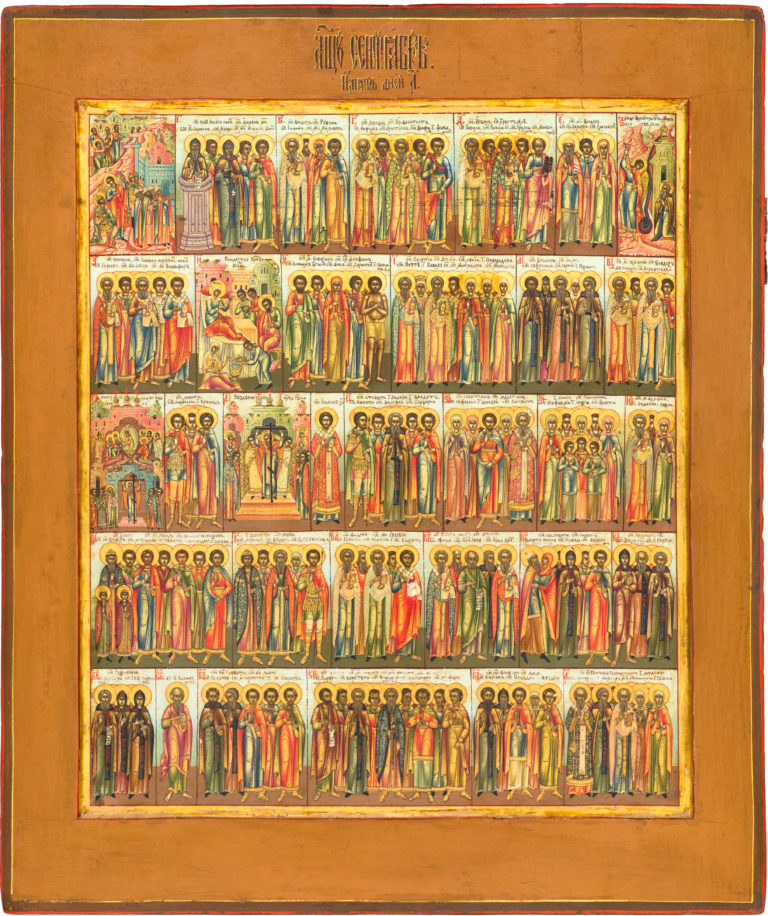The September Menaion
Antique Russian icon. End of the 19th century. Mstyora.
Size: 47 х 38 х 4 cm
Wood (three panels), two incut profiled support boards, a shallow incut centerpiece, underlying layer of canvas is not visible, gesso, tempera.
The author’s paintwork is very well preserved.
Contact us

The September Menaion
The September Menaion was part of a twelve icon complex, which included the Feasts and saints for every month, in accordance with the Menaion – the book that regulated Church celebrations, services, and prayers for every day of the year. The Menologion (or Menaion) hand-painted icons were known in Byzantium since the 11th century. They were derived from the illuminated hagiographical book compilations, as well as Feast cycle illustrations, which could be found on the pages of the Gospel. In Russia, the Menaion Orthodox Christian icons became widespread in the 16th century when, by the initiative of Metropolitan Macarius of Moscow, various menologia texts were compiled into the Great Almanac that included services to all saints venerated and canonized in Russia. Menaion religious icons were meant to be placed on the analoion during the church services. Despite changes in the secular calendar, brought about by the 18th-century reforms, the church calendar remained intact, and the Menaion followed the traditional chronology – beginning in September and ending in August. Thus, the September Menaion inaugurates the church year.
The antique icon’s composition is split into five tiers, each broken up into a series of border scenes with the letters marking the specific day of the month. Not all saints were usually placed into the border scene of that particular day: they were selected by the commissioner. The given hand-painted icon has an extended number of saints and a more detailed iconography of the feasts. On September 1st – the day of the New Ecclesiastical Year – we see the Gospel scene of Christ preaching in the Synagogue of Nazareth, the first time that Jesus witnessed to the fact that the Old Testament prophecies of the Messiah were coming true (Luke 6:17-23). According to tradition, this happened on the first day of the Jewish Feast of the Harvest that came about in early September. September 1st is also the Feast of Saint Simeon the Stylite (called by the Russians the “The Conductor of Summer”) and his mother Martha. Besides Eastern Christian saints, whose presence was established partly by tradition, partly – by personal reasons, this antique Russian icon includes a number of Russian saints – John the Archbishop of Novgorod (September 7th), Theodore, David, and Constantine – the Right Believing Princes of Yaroslavl (September 19th), the Martyr Prince Michael of Chernigov and his boyar Theodore (September 20th), Saint Nikander the Hermit of Pskov (September 24th), Saint Euphrosinia of Suzdal (September 25th), Saint Savvatius of Solovki (September 27th), Prince Vyacheslav of the Czech lands (September 28th), Bishop Michael of Kiev and Saint Gregory of Pelshema, the Vologda Wonderworker (September 30th), as well as Feasts commemorating the burial, the retrieval, and the translation of relics of Russian saints marked only by their figures – for example, the translation of relics of Sergius and Herman of Valaam (September 11th) and the Dormition of Saint Sergius of Radonezh (September 25th).
The hand-painted icon’s artwork fully reflects the aesthetics of the Russian Art Nouveau, which was especially popular in the Imperial Church during the last two decades of the late 19th and the early 20th centuries. The elongated, fragile figures, the mannerist poses clearly visible on the bright blue background, the bright and extravagant color combinations, the special attention to details and gestures, the professional, calligraphic execution of the inscriptions – all of these elements testify to the fact that this antique Russian icon was painted by one of the best Mstyora iconographers for a high-class commissioner. By the middle of the 19th century, the Vladimir village of Mstyora became the main iconographic center of the Russian Empire. The evolution of the local religious icon art tradition and the rapid development of this center were in many ways made possible by a large number of commissions, coming from the Old Believers who lived in the Bogoyavlenskaya sloboda on the Mstyora river. The tastes and ideals of the adherents of the “Old Piety” established the recognizable imagery of the Mstyora religious icon that followed the pre-reform traditions. Local artists were also known as the “old masters” due to their ability to replicate the centuries’ old heritage of Russian iconography. Accepting expensive commissions, Mstyora masters created incredibly detailed hand-painted Orthodox icons, which clearly demonstrates their ability to work in accordance with various Russian icon art traditions and schools.